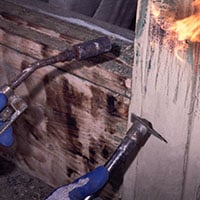Combatting the Dangers of Heavy Metal Contamination: the CDC Can Lead the Way!

This photograph shows a worker using flames from a torch to assist in the removal of paint, demonstrating an exterior renovation method typically used on residences where lead-based paint was present. This method was found to contaminate nearby areas with lead.
Photo credit: Aaron L. Sussell
Exposure to lead has long posed serious health risks, but dangers from occupational and environmental skin exposures to lead and other toxic metals proved difficult to assess until now. Skin contamination (and ingestion) typically occurs from exposure at work including smelters, construction, battery making, and firearm use on the battlefield. It can also result from the environment during recreation, and from lead paint in old homes and buildings. Detection and decontamination in the field remains a daunting challenge to quantify. Ingestion of lead from skin exposure can adversely impact every organ in the body; the kidneys, blood, nervous, and reproductive systems are most affected. There is no known lower threshold limit for lead exposure and harmful health effects.
The National Institute for Occupational Safety and Health (NIOSH), within the Centers for Disease Control and Prevention (CDC), conducted field and laboratory research to study and invent novel ways to detect and decontaminate skin after exposure to lead and other toxic heavy metals. This led to the development of two patented and commercialized technologies; one to detect lead on skin and one to decontaminate skin (washing with soap and water is not highly effective). The NIOSH Handwipe Disclosing Method detects lead on skin and hard surfaces through colorimetric chemistry (a bright red color bloom results on a wipe after contact with lead). The second wipe-based invention decontaminates lead and other toxic metals from skin using a safe and highly effective system. Both technologies are multi-award winners with licensees. Companies have leveraged the federal inventions to create commercial products for sale and use world-wide for lead and toxic metal exposures to skin (and ingestion risks). Private industry, government, and the greater populace now have tools to combat the dangers. The CDC and NIOSH: making a difference in the lives of workers and the public!